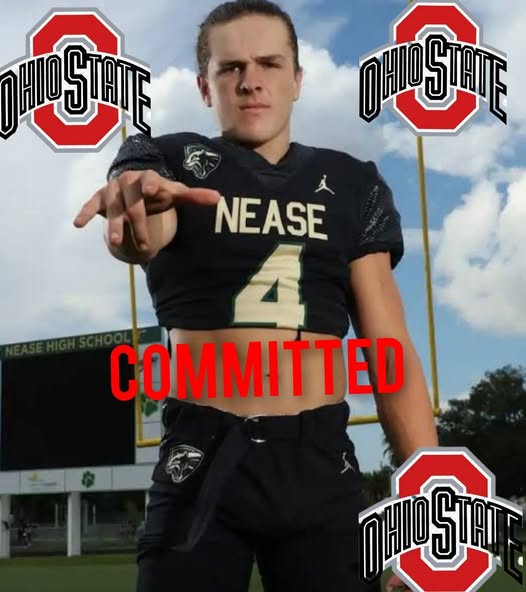In a recruiting shockwave that will reverberate throughout the college football world for months to come, the No. 1 player in America has officially committed to the Ohio State Buckeyes, choosing the scarlet and gray over South Carolina, Louisville, and Tennessee in a decision that cements Ryan Day’s program as a juggernaut on the trail and sends a clear message to the rest of the nation: Ohio State is still the standard.
The announcement came in front of a packed high school gymnasium, filled with local supporters, family members, national media, and a row of anxious coaches waiting to learn where the nation’s top prospect would call home. Clad in a neutral black hoodie and blue jeans, the five-star phenom approached the podium with an air of composure and confidence rarely seen in someone his age. After a few minutes of heartfelt thanks and acknowledgments, he reached beneath the table, pulled out a scarlet Buckeyes cap, placed it on his head, and delivered the words that changed everything: “I’ll be taking my talents to The Ohio State University.”
The gym erupted in cheers, some from friends and family who had known the decision was coming, others from teammates and classmates who understood the magnitude of the moment. The Buckeyes’ fanbase, monitoring social media with bated breath, exploded in celebration. Ohio State’s coaches and recruiting staff immediately took to Twitter (now X) to fire off cryptic emojis and celebratory graphics. The impact of this commitment is seismic.
This wasn’t just any recruit. This was the top-ranked player in the entire 2025 recruiting cycle—a 6-foot-3, 215-pound generational talent who has dominated the high school landscape with a rare blend of size, speed, athleticism, and football IQ. He projects as a game-changing wide receiver at the collegiate level, although some believe he has the ability to transition to safety or even cornerback if needed. His versatility, work ethic, and leadership qualities have set him apart from the moment he stepped on the field as a freshman.
Offers from every blue-blood program in the country poured in early. Alabama, Georgia, USC, Michigan, Clemson, and LSU all made serious pushes. But it was South Carolina, Louisville, and Tennessee who emerged as the final challengers to Ohio State’s throne. And for a while, it wasn’t clear where he would land. Tennessee made an aggressive late push, hoping to sell the promise of immediate playing time and a soaring NIL collective that has made headlines over the past two cycles. Louisville pitched the idea of being the face of a revitalized program, a hometown hero who could lead the Cardinals back into national relevance. South Carolina’s Shane Beamer, one of the most charismatic recruiters in the game, had a personal rapport with the player and his family that almost tipped the scales.
But in the end, tradition, development, and track record won out.
“I chose Ohio State because it felt like home from day one,” the player said following the announcement. “Coach Day, Coach Hartline—they believed in me not just as a player, but as a person. The culture there is different. It’s not about hype, it’s about work. And they’ve proven time and again that they know how to develop guys and get them to the league. That’s where I want to be.”
It’s hard to argue with that logic. Wide receivers coach Brian Hartline has built an NFL pipeline that is virtually unmatched. From Garrett Wilson to Chris Olave, Jaxon Smith-Njigba to Marvin Harrison Jr., and Emeka Egbuka to current rising stars, Ohio State has become the gold standard for wideout development. For a player of this magnitude, it’s not just about where you can play early—it’s about where you can thrive.
“He’s the type of athlete you only get once a generation,” Hartline said in a statement released shortly after the commitment. “He has all the physical tools, but what really separates him is his mindset. He’s humble, driven, and he knows how to compete. That’s what we look for in a Buckeye.”
Ohio State now boasts the No. 1 ranked class in the 2025 cycle following this commitment. Already stacked with talent at quarterback, offensive line, and defense, the addition of the nation’s top player gives them a legitimate argument as the most balanced and elite incoming class in recent memory. More importantly, it reinforces their identity in a rapidly shifting recruiting landscape dominated by NIL discussions, transfer portal drama, and the growing influence of non-traditional powers.
“This commitment reminds people that Ohio State still knows how to close on elite talent the right way,” one Big Ten recruiting analyst said. “In a world where it feels like everybody’s chasing money, this kid chose development, legacy, and long-term success. That says a lot about him—and it says a lot about where Ohio State stands.”
The commitment also carries emotional weight for Buckeyes fans who have endured a few recent frustrations. With Michigan having won three straight editions of The Game and the College Football Playoff expanding to a new 12-team format, some wondered whether Ohio State’s grip on the Big Ten elite was loosening. Not anymore. This is the kind of recruiting victory that can change narratives, shift momentum, and reestablish dominance.
For South Carolina, Louisville, and Tennessee, the sting is real. Each school had reason to believe they were in the mix until the final hours. In Knoxville, there was real hope that the combination of a rising program, strong fanbase, and forward-thinking offense could reel in a player of this caliber. Josh Heupel’s track record with quarterbacks and offensive skill players made a compelling case. And yet, it wasn’t enough.



